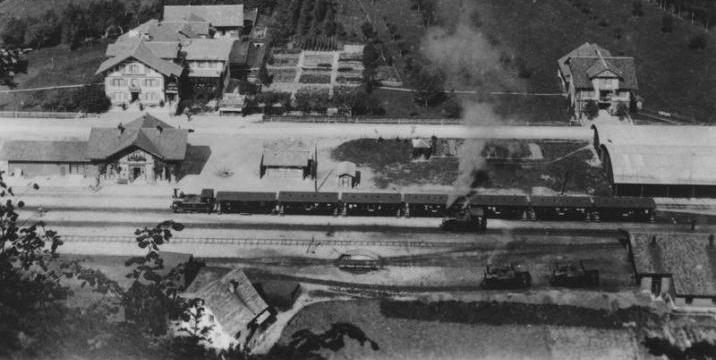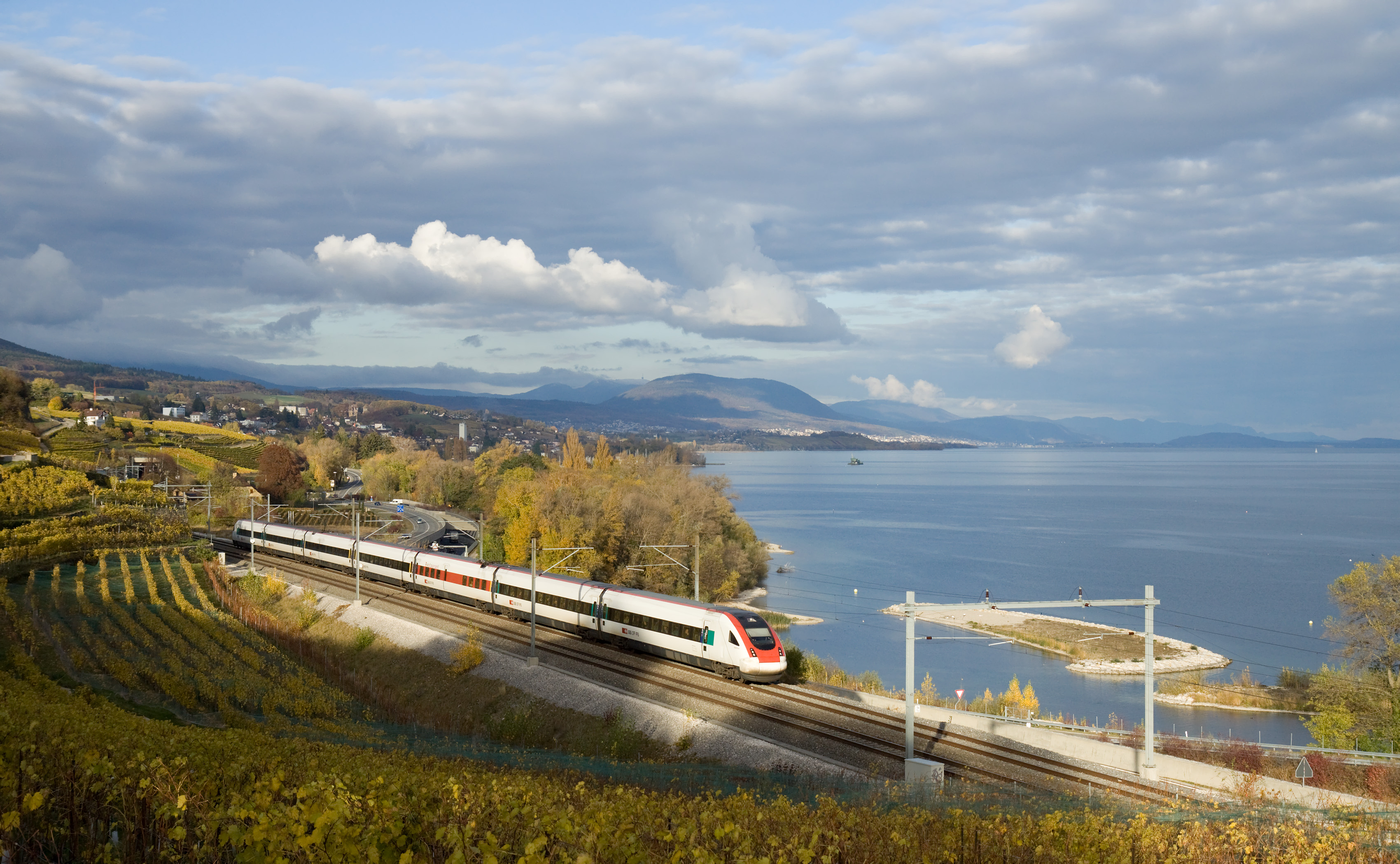|
Chemins De Fer Du Jura Bernois
The Bernese Jura Railway (''Chemins de fer du Jura bernois'', abbreviated ''Jura bernois'', JB) was a railway company in Switzerland. The company was called the Jura–Bern–Luzern (''Jura–Bern–Lucerne'', JBL) from 1 July 1884. The Jura–Bern–Lucerne merged with the Western Switzerland–Simplon Railways (''Suisse-Occidentale–Simplon'', SOS) to form the Jura–Simplon Railway (''Jura-Simplon-Bahn''), JS) on 1 January 1890. History The railway network of the Canton of Bern initially developed according to the interests of the Swiss Central Railway (''Schweizerische Centralbahn'', SCB). The Grand Council of Bern, decided to conclude a contract with the SCB in 1852. The Central Railway undertook to build the Murgenthal–Bern line and the Solothurn–Herzogenbuchsee railway within four years and in return received tax exemption and the privilege of being given preferential treatment in future grants of concessions to build railways. The Central Railway’s constructi ... [...More Info...] [...Related Items...] OR: [Wikipedia] [Google] [Baidu] |
Moutier
Moutier () is a municipality in Switzerland. Currently, the town belongs to the Jura bernois administrative district of the canton of Bern. On 28 March 2021, the population voted to secede from the canton of Bern and join the Canton of Jura; the decision however is not immediately operative and entails a lengthy process of transfer of competences between cantonal authorities. History Moutier is first mentioned in 1154 in the phrase ''datum Monasterii''. In 1181, it was mentioned as ''apud Monasterium'' ('at the Abbey'). The German name for the town is ''Münster (BE)'', but it is not frequently used. The area was lightly settled even before the founding of Moutier-Grandval Abbey around 640. Much of the early history of the village is closely connected with the Abbey. Between 1049 and 1150, the Abbey was granted a stift or land donation to support the college of canons. The stift allowed the Abbey to grow into a major landholder and a regional power. The village church of Sain ... [...More Info...] [...Related Items...] OR: [Wikipedia] [Google] [Baidu] |
Western Switzerland–Simplon Railways
The Western Switzerland Railways (''Chemins de fer de la Suisse Occidentale'', shortened to ''Suisse-Occidentale''; SO or S-O), were initially a joint operation of three Swiss railway companies, but these companies merged on 1 January 1872. The company was called the Western Switzerland–Simplon Railways (''Chemins de fer de la Suisse Occidentale et du Simplon'', shortened to ''Suisse-Occidentale–Simplon''; SOS or SO-S) from 28 June 1881. The SOS merged with the Bernese Jura Railways (''Chemins de fer du Jura bernois''; JBL) to form the Jura–Simplon Railways (''Compagnie des Chemins de Fer Jura–Simplon''; JS) on 1 January 1890. Association of the Railways of Western Switzerland In the early 1860s, the rail links between Romandy and German-speaking Switzerland were controlled by three railway companies, the West Switzerland Company (''Compagnie de l’Ouest Suisse''; SO), the Franco-Swiss Company (''Franco-Suisse'', FS) and the Lausanne–Fribourg–Bern Railway (''Chemi ... [...More Info...] [...Related Items...] OR: [Wikipedia] [Google] [Baidu] |
Bahnhof Giswil 1890
Bahnhof (German for "railway station") is a Swedish Internet service provider (ISP) founded in 1994 by Oscar Swartz in Uppsala, Sweden, and is the country's first independent ISP. Today the company is represented in Stockholm, Gothenburg, Uppsala, Borlänge, Malmö and Umeå. WikiLeaks used to be hosted in a Bahnhof data center inside the ultra-secure bunker Pionen, which is buried inside the White Mountains in Stockholm. History Bahnhof was founded in 1994 by Oscar Swartz. It was one of Sweden's first ISPs. The company is publicly traded since December 2007 under the name BAHN-B (Aktietorget). On 11 September 2008, Bahnhof opened a new computer center inside the former civil defence center Pionen in the White Mountains in Stockholm, Sweden. Controversies On 10 March 2005, the Swedish police confiscated four servers placed in the Bahnhof premises, hoping to find copyrighted material. Although these servers were located near Bahnhof's server park (in a network lab area) ... [...More Info...] [...Related Items...] OR: [Wikipedia] [Google] [Baidu] |
Le Havre
Le Havre (, ; nrf, Lé Hâvre ) is a port city in the Seine-Maritime department in the Normandy region of northern France. It is situated on the right bank of the estuary of the river Seine on the Channel southwest of the Pays de Caux, very close to the Prime Meridian. Le Havre is the most populous commune of Upper Normandy, although the total population of the greater Le Havre conurbation is smaller than that of Rouen. After Reims, it is also the second largest subprefecture in France. The name ''Le Havre'' means "the harbour" or "the port". Its inhabitants are known as ''Havrais'' or ''Havraises''. The city and port were founded by King Francis I in 1517. Economic development in the Early modern period was hampered by religious wars, conflicts with the English, epidemics, and storms. It was from the end of the 18th century that Le Havre started growing and the port took off first with the slave trade then other international trade. After the 1944 bombings the firm ... [...More Info...] [...Related Items...] OR: [Wikipedia] [Google] [Baidu] |
Schweizerische Centralbahn
The Swiss Central Railway (''Schweizerische Centralbahn''; SCB or S.C.B.) was one of the five major private railway companies of Switzerland. The SCB with a track length of 332 kilometres was integrated into the Swiss Federal Railways (SBB) in 1902. History The SCB based in Basel was founded on 4 February 1853 by Johann Jakob Speiser, Achilles Bischoff and Karl Geigy. The shares were mainly owned by Parisian banks. But Basel banks and the cantons of Basel-Stadt and Basel-Landschaft were also involved. The issue of shares worth Swiss Francs (CHF) 36 million and bonds worth CHF 12 million were planned. Speculation on the Paris stock exchange, however, led to a sharp fall in prices. Thus, the value of the SCB shares fell from CHF 500 to 200 and the share capital finally amounted to only CHF 14.5 million. The cantons of Luzern and Bern and Bernese municipalities rescued the company by buying shares and subsidies totaling CHF 6 million. The main goal of the SCB was the constr ... [...More Info...] [...Related Items...] OR: [Wikipedia] [Google] [Baidu] |
Jura Neuchâtelois
The Jura Foot Line (french: ligne du Pied-du-Jura, german: Jurafusslinie) or Jura South Foot Line, is a railway line in Switzerland. It runs from Olten along the foot of the southern Jura range through Solothurn, Grenchen, Biel/Bienne, Neuchâtel, Yverdon-les-Bains and Morges to Lausanne. It is one of two routes used by intercity trains between Geneva and Zürich. The other is the Midland line (German: ''Mittellandlinie'') which connects Olten via Langenthal, Burgdorf, Bern, Fribourg, Lausanne to Morges. The line was built by five railway companies, which after several mergers were absorbed into the Swiss Federal Railways in 1903. The line is electrified at 15 kV 16.7 Hz AC and is two track almost throughout. The sole remaining single section, south of Twann station and north of Neuveville, is the location of the new Ligerz Tunnel. This is due to open at the end of 2026 and will complete the double-tracking of the line. The southern part of the line forms part of the Lau ... [...More Info...] [...Related Items...] OR: [Wikipedia] [Google] [Baidu] |
Neuchâtel–Le Locle-Col-des-Roches Railway
The Neuchâtel–Le Locle-Col-des-Roches railway is a single-track standard-gauge line of the Swiss Federal Railways (SBB). History The line from Neuchâtel to La Chaux-de-Fonds, continuing to Le Locle, was built in four stages between 1857 and 1860 by the Jura industriel (Jura industrial, JI). The JI was taken over in 1875 by the Jura bernois (Bernese Jura Railway, JB), which changed its name to the ''Jura–Bern–Luzern-Bahn'' (JBL) in 1884. The JBL extended the railway to the France–Switzerland border at Le Locle-Col-des-Roches (then Brenets-Col-des-Roches) and connected it through the Col des Roches tunnel and the line to Besançon with the French railway network of the Paris-Lyon-Méditerrané (PLM) company. On 1 January 1886, the 38.21-kilometre-long Neuchâtel–Le Locle-Col-des-Roches railway line was separated from the Jura-Bern-Luzern-Bahn (JBL) and integrated into the newly founded Jura neuchâtelois (JN), which was taken over by the canton of Neuchâtel. ... [...More Info...] [...Related Items...] OR: [Wikipedia] [Google] [Baidu] |
Alpnachstad
Alpnach is a village in the canton of Obwalden in Switzerland. It comprises the villages of Alpnach Dorf, Alpnachstad and Schoried. History Alpnach is first mentioned about 870 as ''Alpenacho''. Geography Alpnach has an area, , of . Of this area, 32.1% is used for agricultural purposes, while 54.1% is forested. Of the rest of the land, 5% is settled (buildings or roads) and the remainder (8.9%) is non-productive (rivers, glaciers or mountains). The municipality is located on the heights above two streams, the Large and Small Schliere. During the mid-19th Century the village became a linear village. While in the 20th Century, it expanded into a ''Haufendorf'' (an irregular, unplanned and quite closely packed village, built around a central square). It consists of the villages of Alpnach Dorf, Alpnachstad and Schoried. Demographics Alpnach has a population (as of ) of . , 13.2% of the population was made up of foreign nationals. [...More Info...] [...Related Items...] OR: [Wikipedia] [Google] [Baidu] |
Langnau Im Emmental
Langnau im Emmental is a municipality in the administrative district of Emmental in the canton of Bern in Switzerland. It is situated in the upper Emmental between Bern and Lucerne. It has about 9,000 inhabitants and is the most important market place in the region. It is set among rolling hills. The average temperature is , and the average precipitation is . The village is one of the sunniest in Switzerland, with practically no fog. History There are no signs of human inhabitants before the German migration in about the 11th century. The first mention of the name Langnau (German ''lange Au'' or ''Lanngnouw'' meaning ''long pasture/meadow'') dates to 1139. In 1246 it was mentioned as ''Langenowe''. Like other towns in the Emmental, Langnau was not built along the river because of the danger of flooding. Instead, it was built on higher ground along one of the streams flowing into the Emme. The earliest noble landowners seem to have been the Kyburg family. A fort was ... [...More Info...] [...Related Items...] OR: [Wikipedia] [Google] [Baidu] |








